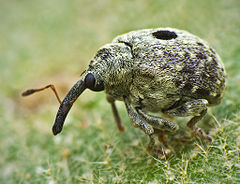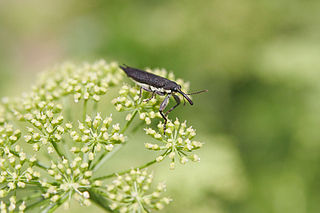
Weevils are beetles belonging to the superfamily Curculionoidea, known for their elongated snouts. They are usually small, less than 6 mm in length, and herbivorous. About 97,000 species of weevils are known. They belong to several families, with most of them in the family Curculionidae. Some other beetles, although not closely related, bear the name "weevil", such as the biscuit weevil, which belongs to the family Ptinidae.
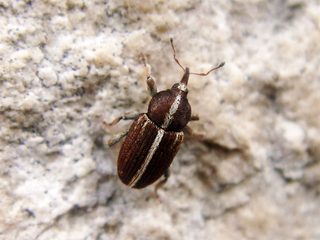
The beetle subfamily Curculioninae is part of the weevil family Curculionidae. It contains over 23,500 described species in 2,200 genera, and is therefore the largest weevil subfamily. Given that the beetle order (Coleoptera) contains about one-quarter of all known organisms, the Curculioninae represent one of the – if not the – most successful radiations of terrestrial Metazoa.
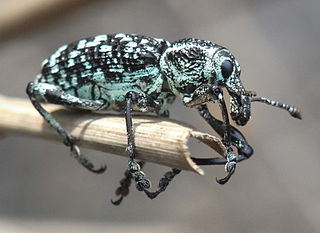
Chrysolopus spectabilis is a species of weevil found in south-eastern Australia. It was discovered during James Cook's first voyage, and became the first insect to be described from Australia. The weevil measures up to 25 mm (1.0 in) long and includes distinctive metallic green and black scales. It is found only on 28 species of the plant genus Acacia.

The mullein moth,, is a noctuid moth with a Palearctic distribution.

Scrophularia californica is a flowering plant in the figwort family which is known by the common names California figwort and California bee plant.

Halyzia sedecimguttata, or orange ladybird, is a species of Coccinellidae (ladybirds) family.
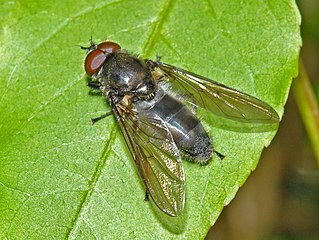
Cheilosia variabilis, common name figwort cheilosia, is a species of hoverfly belonging to the family Syrphidae.

Arima marginata is a species of leaf beetles of the subfamily Galerucinae in the family Chrysomelidae.

Otiorhynchus armadillo is a species of broad-nosed weevil belonging to the family Curculionidae, subfamily Entiminae.
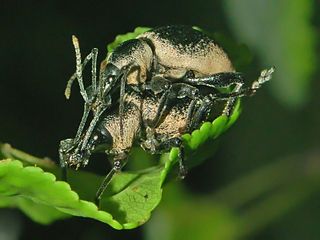
Otiorhynchus vehemens is a species of broad-nosed weevils belonging to the family Curculionidae, subfamily Entiminae.

Polydrusus formosus is a species of broad-nosed weevil belonging to the family Curculionidae, subfamily Entiminae.

Sibinia subelliptica is a species of acorn and nut weevils belonging to the family Curculionidae, subfamily Curculioninae.

Tenthredo scrophulariae, the figwort sawfly is a species of the family Tenthredinidae, subfamily Tenthredininae.

Scrophularia auriculata, the shoreline figwort or water figwort, is a perennial plant of the genus Scrophularia in the family Scrophulariaceae. It is found commonly in Western Europe and North Africa, on the margins of rivers, ponds and similar damp places. It is an upright plant reaching 70 cm with blunt oval, crenate leaves in alternate pairs on the greenish–purple square stem, most leaves may have two small lobes at their base. The spikes of flowers are held stiffly on square stems which arise from the main stem in the angle of the leaf stalks. The square stems have a wing running down each corner. These wings are more obvious than on the closely related common figwort. The flowers are small, maroon-brownish and globular with two small lips above and below. The five sepals are green with a white margin, broader on the water figwort than the common figwort. The plant flowers from June to September after when the flowers produce small spherical to pear-shaped capsules containing a large number of seeds.

Apoderus coryli, common name hazel-leaf roller weevil, is a species of leaf-rolling beetles belonging to the family Attelabidae subfamily Attelabinae. Because of the trunk-like elongated head, it is often mistakenly attributed to the weevils.

Oberea pupillata is a species of beetle in the family Cerambycidae. It was described by Leonard Gyllenhaal in 1817, originally under the genus Saperda.

Bibio hortulanus, common name marchfly, is a species of fly from the family Bibionidae.
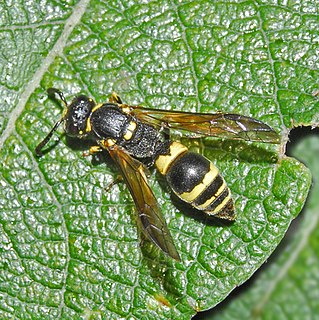
Symmorphus gracilis is a species of tube-nesting wasps.

Sphenophorus parvulus, the bluegrass billbug, is a species of beetle in the family Curculionidae. It is found in North America, especially in the eastern United States. It is a pest of Kentucky bluegrass, other grasses, corn and grain crops.

Lyperobius hudsoni is a flightless weevil found in alpine areas of Central Otago and Otago Lakes in the South Island of New Zealand.

